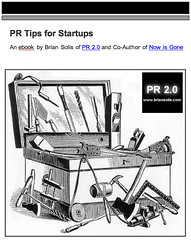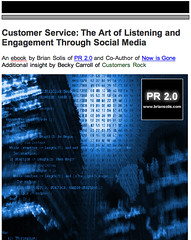The Escalator Pitch, Going Up?

The escalator is the new elevator when it comes to pitching and the emerging practice of micro public relations.
While some bloggers and reporters are actively blacklisting PR people, whether it's fair or not, it's not truly fixing or changing anything at a grand scale - at least not yet. I'm part of a growing number of PR folks who are committed to sharing stories, experiences, tools, practices, and ideas on how to specifically fix the relationships between PR and influencers.
But, it's not only PR people who are guilty of unfocused and irrelevant storytelling (spam), it's also company executives and founders who lose a bit of perspective during the reality and grind of product development. In a sense, it puts the blinders on making it incredibly difficult for entrepreneurs to transcend their passion into something more substantial to those outside of their day-to-day ecosystem. This doesn't only correlate to bad or even worse, zero publicity, it affects everything from financing to business development to valuation.
So, I'm here throwing my hat into the ring to also help company executives, as well as PR representatives, condense their pitch into something more palatable, important, promising, and also intriguing. This is an exercise in how you can help those that matter to your business quickly get to the point where they want to know more about your company.
We've all heard of the elevator pitch.
As our attention span thins and tests the true extent of our elasticity, many are finding that most businesses still can't tell their story quickly and concisely without superlatives, buzzwords, technical jargon, and deafening marketing speak. The answer to "what do you do?" doesn't yield much, usually requiring the person listening to ask further qualifying questions in order to get a truly meaningful and relevant answer.
I'm sorry to say that most people don't have the time, patience, or attention to continually ask for more information - nor should they. The onus is on you to tell your story in a way that helps them get it, almost instantly. And, you want them to do something about what they're hearing, not just nod their head in agreement.
That's right. Forget the elevator pitch, it's time to hop on an escalator to a more effective company pitch.
Introducing the escalator pitch.
My good friend Stowe Boyd, recently introduced the concept of the #TwitPitch, a very streamlined way for using Twitter to simplify the process of booking briefings with companies during the show. It forced companies to distill their message in 140 characters, which, in the process, will hopefully tighten and streamline the typical elevator pitch. As Stowe says, “I think twitpitch takes the elevator pitch to new brevity: the escalator pitch.”
The idea of the escalator pitch is game changing and powered by the brevity that takes place on Twitter every minute of every day. It inspires us to embrace brevity and relevance outside of twitter, in the real world, to help people "get" what we do and why they should care.
I've been on the receiving end of elevator pitches for years, and I can honestly tell you that most are much longer than most elevator rides and most certainly, very difficult to discern the value within each - regardless of whether or not the product or service is indeed promising or revolutionary. Simply said, don't assume that anyone is going to see things the way you do.
Several factors usually contribute to ineffective pitches:
1- Lack of presence or conviction
2- Absence of enthusiasm or the over reliance on enthusiasm
3 - Inability to connect with audience
4 - Not knowing who the audiences really are
5 - Dilution of the story with buzzwords and jargon
6 - The story is missing the human factor
7 - No insight for how this changes the world
8 - The path for the future is usually shortsighted
9 - The connection to "what's in it for me" or "how does this improve my flow" are usually missing
10 - A call-to-action is usually overlooked
11 - The misperception that no competition exists
With the introduction of the escalator pitch, spokespersons now face a greater challenge, and with it, a new opportunity, to make a first and lasting impression.
BusinessWeek recently published an article on the philosophy and potential of the escalator pitch and micropitching as a new art form. It featured insight from Stowe and also a quote from yours truly.
The article states that Stowe's "experiment offers a lesson for small companies that want the attention of potential investors, clients, and press: Get to the point."
In the article, I was asked to answer what makes a good escalator pitch? I answered, "Brevity and relevance. It's about focus and precision, and it needs to be aligned and presented in a way that reflects who you write to and why it's beneficial to your readers."
BusinessWeek further summarized my series of responses, "That means tailoring your message to your audience. Tell investors how you're going to make money, tell customers how you're going to solve their problems, and tell bloggers why their readers should care."
According to a Sequoia Capital investor, when Sergey Brin and Larry Page (the Google founders for those who don't know) first approached the firm, their passion, brevity, and clear vision was contagious and inspiring. It's now known as the eight-word pitch that opened the door to further conversations. The founding duo stated that Google would provide "access to the world's information in one click."
It's about saying and demonstrating the things that will continually escalate your opportunity to the next level to say and demonstrate more - earning believers, evangelists, investors, stakeholders, customers, and partners along the way.

In the spirit of TwitPitch and the escalator pitch, Stowe and I last week announced MicroPR, a new service to help connect PR and media/bloggers on Twitter through the practice of pitching from concentrate - again emphasizing succinctness. MicroPR leverages micromedia, starting with Twitter, to connect journalists, bloggers, analysts and PR/marketing together in an efficient, unobtrusive, targeted, and productive way.
I highly recommend that reporters, journalists, bloggers, analysts, and anyone looking for support in story development use it to connect with communications professionals. Likewise, PR people should follow @micropr in order to see these requests as they appear in the Twitter stream.
In its Alpha form, MicroPR will help channel information, starting as a service for media to source stories, share their preferences for receiving information, announce change of beats, call for speakers or awards submissions, or anything that needs to hit a very focused list of savvy and connected PR professionals. Media, bloggers, and PR people, THIS IS A MUST READ.
Get on the Escalator
Honestly, condensing and elevating your pitch and matching it to the specific audience can only help recruit supporters. It’s storytelling, except the story is written 100 different ways - all equally compelling. And, it’s cognizant and representative of to whom you’re speaking. Investors want to know how what you’re doing is going to add value to a market and how and why they're going to embrace it - as well as evaluating the prospect for financial gain. Customers need to hear how what you do solves problems or pains that they may have – or may soon experience. Those customers also have different needs determined by their marketplace. The same is true for the reporters and bloggers who are regarded as resources by each customer demographic - they need to hear things specific to their workflow and community.
The same exercises and practices of micro messaging are critical for helping company spokespersons distill their story for every step of the business process, from funding to sales to exit, in order to seed interest and support and grow the business opportunity as well as the bottom line and overall valuation.
Take it seriously, you are not above improvement.
Assume you have one shot at getting someone excited about what you're doing, because, technically, you do.
Make sure to clearly express who this is different than anything else out there and how it benefits the people who'll use it.
Get friendly feedback.
Rehearse your pitch, continually.
Tighten it.
Evolve it based on reactions.
Share your story in 60 seconds or less, each and every time.
Shape it to include the key points specific to the group to whom you're speaking.
If you can nail it on an escalator, the elevator pitch will seem like a luxury.
Going up?
Connect with me on Twitter, Jaiku, LinkedIn, Pownce, Plaxo, FriendFeed, Tumblr, or Facebook.
elevator+pitch escalator pitch social+media businessweek brian+solis stowe+boyd twitpitch twitter micromedia pr public+relations financing investor google social media pr+2.0 micropr news media+2.0 media2.0 marketing











4 Comments:
Excellent work, Brian. I'd be thrilled if you wanted to share some of this at www.bloggersandpr.com, a wiki my firm helped build with the Council of PR Firms to help craft best practices and ask both PR pro's and bloggers for their thoughts.
Right on! #TwitPitch to go... Strategy, focus, clear connection with audience come together in this post.
Items like dropping "push message" with superlatives and distraction, and getting to core of What? Testing - Why care?
Only connect...sound steps here!
Brilliant Job! I found this to be tremendously helpful to me as a newbie entering the blogosphere. I'm sure I'll need to refer to it more than once.
Hey Brian,
Yeah, I've been doing a video version of an elevator pitch on my blog for a bit, but the twitter version of an escalator pitch is a great idea too.
Even harder than 15 seconds on video!
Jim Kukral
Post a Comment
<< Home